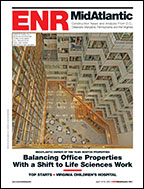Boston’s Big Dig tunnel has one more problem. Thawing from ground-freezing technology used to excavate the I-90 connector system 11 years ago has apparently caused a large swath of soil to settle. Engineers fear that a deep water-filled void may be lurking beneath.
The area of concern beneath the I-90 tunnel base slab measures 190 ft long by 60 ft wide, says Frank DePaola, appointed Massachusetts Dept. of Transportation’s new highway administrator on August 11. It is one of the largest and perhaps deepest applications of ground freezing in the U.S., reaching 130 ft. at its deepest level, he says.
Although the settling soil has caused damage to a drainage pipe and is causing ongoing need for Amtrak track alignment, MassDOT officials say the tunnel system is safe.
“We have been monitoring the area’s surface monthly since 2002, when the chiller plant was stopped and [engineers] theorized there is potentially a void because soil is settling below the tunnel,” DePaola says. “If there is a void, we know it would be filled with water because it is at the bottom of the tunnel, approximately 40 ft below the ground water table.”
Massachusetts Rep. Stephen F. Lynch (D) has requested a thorough inspection and structural assessment from the MassDOT and the Federal Highway Administration. “The safety of the public must be our top priority,” he says.
MassDOT has hired joint venture Boston-based FTV Parsons as an independent structural consultant to calculate stresses caused by the settling soil. “They issued a report concluding the tunnel could take those stresses within reasonable safety,” DePaola says.
Meanwhile the area of settling soil has raised questions. “We are puzzled as to why the clay soil is retracting more than it swelled although it was initially frozen,” DePaola says. MassDOT hired GZA GeoEnvironmental Inc., Norwood, Mass., to study data on clays and soils to answer that question.
MassDOT has also observed that the total area of settlement is larger than expected.
MassDOT and its consultants have developed a plan to fill any voids with cement grout once the thawing is expected to be complete in 2014. “We’re looking for something we can install by drilling in from the surface rather than excavating,” DePaola says.
Problems with settling soil also caused damage to an Amtrak power line, DePaola says. In 2007, MassDOT funded a temporary repair of the traction power line by removing it from a duct bank; as the soil settled, it put cables into tension, DePaola says. “It is now laid on the ground surface of a stone ballast between the rails.” When the area has finally finished settling, the cable will be installed in a new duct bank, he says.
Ed Jaroszewicz, director of climate technologies at Wacker Neuson Production Americas, which provided ground heating equipment to support Big Dig tunnel excavation, says ground behavior is difficult to predict since varying soils behave differently.
“At the base of the tunnel is Boston Blue Clay, but as you go down from the surface you’ll find a mix of organics,” including organic silt with some fine sand and peat and beneath that lenses of alluvial sand and inorganic silt deposits with complex behavior, DePaola says.
“Most frost in North American is 3 ft to 4 ft deep, but in the Dakotas or Minnesota, for instance, you can find 11- to 12-ft-deep frost. When you get 130 ft beneath the surface, you will find water starting to collect during the freezing process. In deep thaws, at 10 to 11 ft you can have a heavy concentration of water instead of water and soil. With more water, more ice can form and that results in more expansion since water is denser than ice and soil can start to heave,” DePaola adds.



Post a comment to this article
Report Abusive Comment